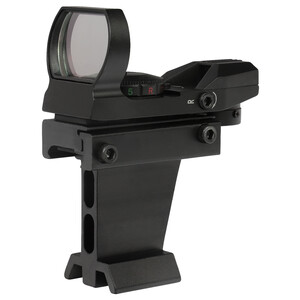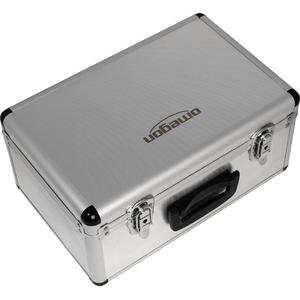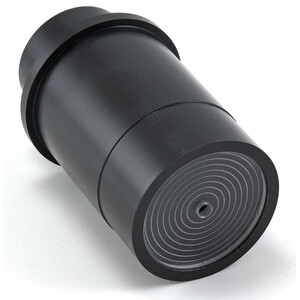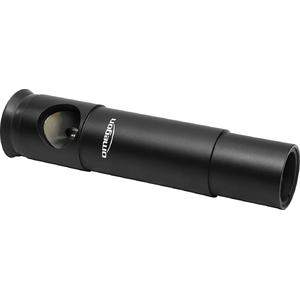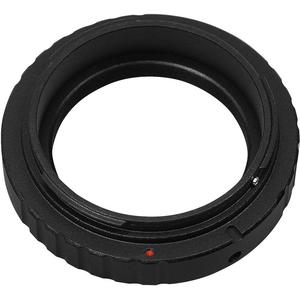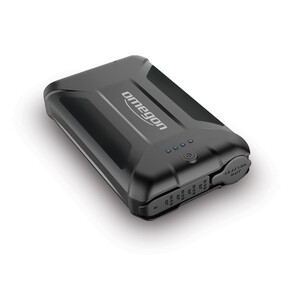Colimador láser Hotech - Para colimar el telescopio sin problemas
Imagínate esto: Estás observando las estrellas a través del telescopio pero sientes que algo no está bien... ¿Qué pasa? ¿Por qué no se ven las estrellas con nitidez? Júpiter... Sí, hay algo raro - las imágenes no tienen buen contraste. Aunque la noche es clara no estás disfrutando de la observación. Obviamente tiene que ver con que el telescopio no está perfectamente colimado... Y para corregir esto, ¿qué mejor que un colimador láser?
El láser que se centra solo
Algunos colimadores láser sencillos se mueven dentro del portaocular. Esto no pasa con el colimador Hotech. Gracias a su diseño, se centra solo, evitando así movimientos indeseados. Tampoco se tiene que atornillar al portaocular. Atornillar el colimador al portaocular puede resultar en daños en este último. Este problema también queda solucionado con el colimador láser Hotech
Es posible colimar el telescopio una vez situado sobre la montura, la colocación en paralelo del colimador está garantizada.
Ventajas:
- colimación precisa: láser de auto-centrado
- el láser se mantiene en paralelo sin moverse
- puntero láser muy fino
- panel de proyección de 45° para una colimación sencilla
- la versión de 2“ incluye un adaptador de 2" que también se centra solo
- disponible en dos tamaños: 1,25“ o 2“ (ver descripción del producto)
- larga vida útil: pila de 3V
- incluye estuche
Retículo
El láser Hotech cuenta con un retículo que se proyecta en el panel. Cuando el puntero láser desaparece en el agujero central del colimador el retículo permite realizar correcciones precisas en la colimación.
Colimador láser HOTECH SCA con adaptador de centrado automático (SCA)
El colimador láser HoTech se diferencia de sus competidores por su tecnología de centrado automático (SCA). Este mecanismo se puede instalar (repetidas veces) en cualquier enfocador de 1,25" y 2" proporcionando resultados de precisión. Todos los colimadores del mercado tienen un inconveniente: se pierde precisión en todo el eje óptico al asegurar el colimador por culpa del hueco necesario para la instalación del mismo. Este problema es conocido por todos los astrónomos y aunque suele ser tema a debatir, no se ha encontrado aún ninguna solución definitiva. El adaptador de centrado automático elimina el hueco del enfocador aplicano una compresión lineal sobre los anillos de goma integrados. De esta forma, se expande el diámetro de los anillos compensando el hueco. Como el diámetro de todos los anillos se expande acordemente, el colimador queda centrado en el tubo del enfocador. Además, el colimador láser SCA puede acoplarse firmemente al enfocador para proporcionar colimaciones precisas una y otra vez.
En resumen: El adaptador SCA tiene tres funciones principales: 1ª. Sus anillos son capaces de adaptar casi todos los modelos disponibles. 2ª. Mantiene el colimador centrado. 3ª. Proporciona al menos dos puntos de apoyo circulares en la superficie del tubo interior del enfocador evitando así que el láser se gire o mueva manteniéndolo siempre paralelo al enfocador. Una vez resuelto el problema del hueco, el telescopio se puede colimar rápidamente y obteniendo siempre buenos resultados.
Problema resuelto gracias a la tecnología SCA
- SCA elimina el hueco en el tubo del enfocador
Todos los tubos tienen una cierta tolerancia de fábrica. Se necesita un mayor diámetro de tubo para conseguir una mayor compatibilidad con diferentes modelos de oculares y adaptadores. Al insertar un colimador estándar, el hueco que queda entre el tubo y la pieza de insercción nos crea un problema. Los anillos de goma en el adaptador SCA se expanden radialmente para cubrir el hueco. Esto hace que el colimador se mantenga firme en el tubo, integrándose en el telescopio y sea capaz de proporcionar buenos resultados una y otra vez.
- SCA mantiene el láser paralelo al enfocador
Los anillos expansores patentados proporcionan una sujeción en 360º a la superficie interior del enfocador gracias a su competente diseño. Esto mantiene el láser completamente paralelo al tubo del enfocador eliminando así cualquier movimiento no deseado presente en el método convencional de fijación.
- SCA elimina los problemas de una fijación inestable
El eje óptico se mueve cuando el sistema de inserción se asegura con un tornillo mariposa. En otros casos, un anillo de compresión mal hecho puede hacer que el sistema se gire. El sistema SCA consigue mejores resultados sin necesidad de tornillos ni anillo de compresión unificado.
- SCA compensa la imperfección de los tubos de enfoque
Las pequeñas imperfecciones presentes en los tubos del enfocador se ven compensadas por los anillos de goma, alcanzando así un mayor centrado del colimador. Incluso si el diámetro del tubo está deformado y no es perfectamente redondo. Solo un anillo de goma puede adoptar otra forma para compensar la imperfección.
Más funciones del colimador láser SCA:
- Laser Engraved 45º Targeting Faceplate
The targeting faceplate displays the returning laser spot with a clear visual reference during adjustment. That allows you to align your primary mirror from the rear of the telescope and eliminates traveling to the front of your scope repeatedly during collimation. Collimating without the targeting faceplate, you will not be able to adjust the primary mirror in real time referencing the laser dot. In other words, you often get lost on which adjustment screws you used due to traveling back and forth for referencing the direction you have adjusted. This results in considerable time to complete the collimation and defeats the purpose of quick and easy laser collimation. HoTech understands the importance of this, so the faceplate is a standard feature in our laser collimator. All astronomers deserve to have it without paying any extra! In addition, the faceplate viewer’s pattern is laser engraved to ensure a long lasting sharp targeting grid for best visual effects. Unlike other collimators, the target is not a sticker that will peel, or paint that can rub or chip off. We understand that you are paying for a precision instrument that is supposed to be well made.
- Finest Projecting Laser Dot
Keeping the laser dot to the finest point is the key to precision collimation. But when you look closely at the laser dot from brand to brand, most laser dots appear large, not really a fine point as you imagined. This means there is guess work involved when you try to center the dot; not just centering the laser dot to the center of the faceplate, but also centering the center of the dot itself. This does not make any sense when you are trying to take the advantage of the collimated laser beam's characteristic "which has a low beam divergence, so that the beam radius does not undergo significant changes within moderate propagation distances." In other words, the laser beam size within the collimation distance (laser collimator to the primary mirror and back to the faceplate) should remain a constant fine point. As you know, most laser collimator brands are not really laser manufacturers. They install an off-the-shelf laser module or pointer and align the laser in a tube without REALLY considering the user’s application, namely the operating distance for a laser beam size. HoTech has been designing and building laser modules and systems for over 10 years for various professional industries. We know exactly how a laser should work. We limit our laser beam to the finest size in the correct operating distance for optimal effect. Our understanding and experiences with the laser design permit you to have an effective and precision collimation.
- Proprietary Crosshair Laser Collimator Available
With our proprietary laser crosshair, user can zero-in the laser with ease during the final collimation on the secondary and the primary mirror. The crosshair model still exibits a precision laser center dot, but with a touch of four extended laser lines from the center dot. The extension lines (crosshair) of the laser dot is the most intuitive way to guide the laser pointing for an accurate adjustment. During the secondary mirror collimation, a single dot laser projecting on the approximate center of the pre-loaded donut is difficult to identify if the laser dot is exactly on the center. The crosshair laser can easily help user to adjust the secondary mirror to point the laser on the exact center with the help of the crosshair line. During the final primary mirror collimation, the returning laser dot often hides into the laser exiting hole preventing user to identify if the returning laser is at exact center of the hole. Again, the crosshair will visually guide the user to center the laser dot with ease even when the center laser dot disappears into the exiting hole. It is a very effective and essential feature to the SCA Laser Collimator in obtaining at even higher degree of accuracy with ease. Click here for a video tour on YouTube.
- High Accuracy Laser Alignment
The Hotech laser collimator is well centered and aligned which are critical factors for an accurate collimation. But you will be surprised that many laser collimators in the market fail in this regard. The reason is in the design and understanding of the product itself. Hotech considered all aspect of parameters in their design. Parameters like the alignment mechanism, mechanical and optical structure of the laser itself, and more are taken as part of our design. For instance, some laser collimators actually install an off-the-shelf laser pointer in the casing. It is very cost effective (for seller), but it inherits numerous problems. In many cases, the laser pointer might not install perfectly centered in the casing due to pointer size variations and the added alignment mechanism. So the laser itself is not positioned on the true alignment point and optical axis. As the result, the laser can never be center-aligned in the enclosure. It is possible to align the laser beam parallel to the optical path but always with an offset along the optical axis. This means the laser beam is off no matter how you center adapt the laser collimator to the focuser. The result of off-centered laser will introduce astigmatism into your telescope which is similar to figure 1's scenario.
- Light Weight Design and All Aluminum Body Machined with High Precision CNC
Many laser collimator manufacturers give users the wrong impression, “big and heavy means rugged and stable.” Instead, HoTech engineers successfully cut the unnecessary weight on the laser collimator because we understand that additional weight on a telescope (especially open structure Newtonians) will create imbalance and structure sagging. In addition, the heavier the device is, the more inertia it will have during an impact from an accidental drop. In such an accident, the inertia force can cause more damage to the internal alignment mechanism because there is more energy required to dissipate from the impact. Therefore, the lightweight design on our laser collimator makes you gain reliable precision collimation. And of course our laser collimator uses aero-space grade lightweight aluminum material and CNC machined with the tightest tolerances, then sand blasted and anodized to protect from harsh environment. Nothing has been sacrificed while you get a long lasting state-of-the-art collimation instrument.
- Long Lasting Battery Life
By using the CR123, 3V battery as our laser power source, our laser collimator has over 65 hours of continuous use battery life time. The included CR123, 3V lithium battery operates well under a typical cold night and it has a 10 years shelf life. This is a great advantage that you don't have to worry about changing the tiny hard to find cell batteries frequently in the dark like other collimators.
Commercially made SCTs all have slight optical and mechanical alignment errors. The error typically is in the centering of the secondary mirror. As the result, when a laser is installed and emitted from the focuser, the beam will seldom return dead center, even though star testing would indicate perfect collimation. In addition, the secondary mirror (convex shape) expands the fine laser dot to a larger spot, and magnifies any axial error by about 5 times. The error of deviation for a typical well collimated SCT will return laser beam at around 0.125" to 0.250" off center. In order to compensate the optical and mechanical alignment errors of SCT, a different collimation approach is required in compare with Newtonain telescope. If the procedure is followed through correctly, users can still accurately collimate their SCT. By default, the laser will have to be position in the optical center of the SCT. HoTech SCA laser collimator automatically eliminates the focuser slop without using the thumbscrew and center position itself on optical axis. For SCT, the primary mirror is fixed, but you can collimate by adjusting the secondary mirror to point parallel to the optical axis. There is an one-time-only preperation you need to do for SCT laser collimation. First, install the SCA laser collimator and premark the laser position on the target grid of the collimator when your telescope is collimated from the factory or from your star collimation. Then when you check for collimation next time, just adapt the SCA laser collimator on the focuser, 2" or 1.25" and see if the laser falls on the premarked laser position. If not, adjust the alignment screws on the secondary mirror to move the returning laser dot to the premarked postion on the target grid. Due to the convex shape secondary mirror surface, the mirror will expand the returning collimating laser to a larger spot making it harder to discern the center of the return laser spot for collimation. For best result, the single laser dot laser model is more suitable for the SCT collimation for ease of finding the center of the expanded spot. See the photos below.
- Diffraction Grating Pattern Lens on our SCA Laser Collimator
Since our SCA Laser Collimator is already accurate with the SCA technology, fine laser dot, and the built-in 45 degrees faceplate, there is no need to use the DFG pattern to align the primary mirror of a Newtonian telescope. The purpose of using DFG pattern is to gross alignment the primary mirror. The user aligns the primary mirror by referencing the shadow of the secondary in the projected DFG pattern on a wall, and user counts the DFG dots around the shadow to center in the shadow. This method cannot achieve accurate alignment because the gap between each dot can make a big alignment difference. At the final alignment stage, the user must bring the laser dot back to the laser exit (the center of the 45 degrees faceplate). Our built-in 45 degrees faceplate allows you to align your primary mirror from the rear of the telescope eliminating traveling to the front of your scope repeatedly during collimation like other collimators. Therefore, there is no need to use DFG lens in conjunction with our SCA Laser Collimator.
